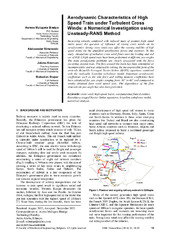Приказ основних података о документу
Aerodinamičke karakteristike vozova velikih brzina pod dejstvom bočnih vetrova - numerička analiza koristeći nestacionarni RANS metod
Aerodynamic characteristics of high speed train under turbulent cross winds: A numerical investigation using unsteady-RANS method
| dc.creator | Biadgo, Mulugeta Asress | |
| dc.creator | Simonović, Aleksandar | |
| dc.creator | Svorcan, Jelena | |
| dc.creator | Stupar, Slobodan | |
| dc.date.accessioned | 2022-09-19T17:27:16Z | |
| dc.date.available | 2022-09-19T17:27:16Z | |
| dc.date.issued | 2014 | |
| dc.identifier.issn | 1451-2092 | |
| dc.identifier.uri | https://machinery.mas.bg.ac.rs/handle/123456789/1931 | |
| dc.description.abstract | Usled trenda povećanja brzina i smanjenja mase modernih vozova velikih brzina neophodno je razmatrati dejstvo jakih bočnih vetrova na njihovu aerodinamiku. Jaki bočni vetrovi mogu uticati na stabilnost ovih vozova usled povećanja aerodinamičke sile i momenta. U ovoj analizi sprovedene su numeričke simulacije turbulentnih bočnih vetrova koji duvaju preko prvog i poslednjeg vagona brzog voza ICE-2 pri različitim uglovima skretanja. Problemi stabilnosti voza su blisko vezani za strujno polje oko voza. Okolni fluid smatran je nestišljivim, a strujno polje oko voza dobijeno je rešavanjem nestacionarnih Rejnoldsovih jednačina (RANS) u kombinaciji sa realizable k-epsilon turbulentnim modelom. Aerodinamički koeficijenti važni za ovu analizu, koeficijent sile klizanja i momenta skretanja, izračunati su za uglove skretanja u opsegu od -30° do 60° i upoređeni sa rezultatima dobijenim u aerotunelu. Kvalitativna analiza zavisnosti strujnih struktura od ugla skretanja je takođe sprovedena i prikazana. | sr |
| dc.description.abstract | Increasing velocity combined with reduced mass of modern high speed trains poses the question of influence of strong cross winds on its aerodynamics. Strong cross winds may affect the running stability of high speed trains via the amplified aerodynamic forces and moments. In this study, simulations of turbulent cross wind flows over the leading and end car of ICE-2 high speed train have been performed at different yaw angles The train aerodynamic problems are closely associated with the flows occurring around train. The flow around the train has been considered as incompressible and was obtained by solving the incompressible form of the unsteady Reynolds-Averaged Navier-Stokes (RANS) equations combined with the realizable k-epsilon turbulence model. Important aerodynamic coefficients such as the side force and rolling moment coefficients have been calculated for yaw angles ranging from -30° to 60° and compared to results obtained from wind tunnel tests. The dependence of the flow structure on yaw angle has also been presented. | en |
| dc.publisher | Univerzitet u Beogradu - Mašinski fakultet, Beograd | |
| dc.rights | openAccess | |
| dc.rights.uri | https://creativecommons.org/licenses/by/4.0/ | |
| dc.source | FME Transactions | |
| dc.subject | Reynolds-averaged Navier-Stokes equations | en |
| dc.subject | numerical analysis | en |
| dc.subject | k-epsilon turbulence model | en |
| dc.subject | high speed trains | en |
| dc.subject | cross-wind | en |
| dc.subject | computational fluid dynamics | en |
| dc.title | Aerodinamičke karakteristike vozova velikih brzina pod dejstvom bočnih vetrova - numerička analiza koristeći nestacionarni RANS metod | sr |
| dc.title | Aerodynamic characteristics of high speed train under turbulent cross winds: A numerical investigation using unsteady-RANS method | en |
| dc.type | article | |
| dc.rights.license | BY | |
| dc.citation.epage | 18 | |
| dc.citation.issue | 1 | |
| dc.citation.other | 42(1): 10-18 | |
| dc.citation.rank | M24 | |
| dc.citation.spage | 10 | |
| dc.citation.volume | 42 | |
| dc.identifier.doi | 10.5937/fmet1401010B | |
| dc.identifier.fulltext | http://machinery.mas.bg.ac.rs/bitstream/id/744/1928.pdf | |
| dc.identifier.scopus | 2-s2.0-84893769593 | |
| dc.type.version | publishedVersion |


